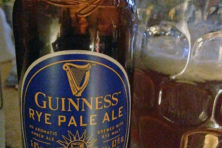The Guinness Pour
- Share
- Tweet
- Pin
- Share
Thirteen million pints of Guinness will be sold on St. Patrick’s Day (not just in Door County, that would cause some problems), many to folks who won’t drink another one the entire year.
Most of those ordering a glass of the Dublin brew won’t know the difference between a good Guinness pour and a bad one, but aficionados swear by a patient, precise method of pouring the world’s signature Irish beer.

Bubbles from the nitrogen gas in the Guinness line make their way to the top to join in the creamy head of a great Guinness pour.
Because Guinness uses a nitrogen/ CO2 blend to push the beer through the tap lines (as opposed to just CO2) it requires a special technique to get the pint just right. The nitrogen gives the beer its creamy head.
Bartenders all have their own methods and tweaks, but the process, according to the official Guinness Web site, is as follows:
Hold the glass (warm, not chilled), tilted at a 45-degree angle, below the tap but not touching it. Fill to ¾ full, then set the glass down (the Web site instructs you to wait for 119.53 seconds, I can only wonder what the .03 adds to your drinking enjoyment). Setting the beer aside allows the gas to bubble through the beer and form the signature creamy head. Once it has settled, tilt the glass again and fill the rest of the way, with the head forming a dome slightly above the rim.
Some bartenders will get fancy and draw a shamrock in the foam. James Larson, who tends bar at Husby’s in Sister Bay, says the key to drawing the shamrock is to draw it early, before topping off the glass so you don’t run out of time.
Such attention, and time, to pouring a single beer is a bit much to ask of a busy bartender.
“When you’re busy with a full bar, it’s hard to leave it sit and not forget about it,” says bartender Bill Budelman of the Bayside Tavern.
Ron MacDonald, owner of the Northern Grill, has spent 35 years behind the bar and says he knows that many bartenders swear by the official method. Still, he taps it like any other beer.
“If it takes you longer to tap it than to drink it then there’s something wrong,” he says. MacDonald himself says he’s had it poured both ways but can’t tell the difference.
Brewed for over 250 years, Guinness has recently surged in popularity in the United States. Ten years ago few establishments carried Guinness on tap, but today it can be found on draught at least 10 Northern Door restaurants.
“What surprises me is nobody has ever really competed with Guinness,” MacDonald says. “You’ve got other dark beers, but nothing made the same way with the nitrogen line. It really has no competitors.”
Any way you pour it.


